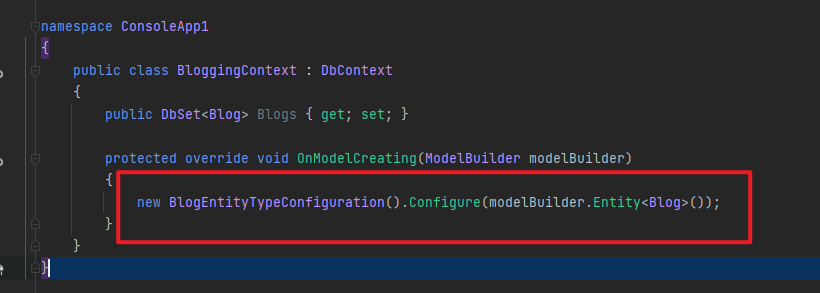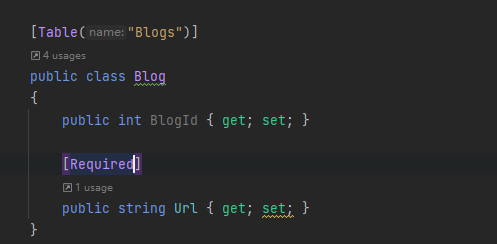前言
简单介绍一下EfCore 的模型篇
正文
内容来源:
配置模型
配置模型的方式,一种是fluent api 还一种是属性的方式。
public class Blog
{
public int BlogId { get; set; }
public string Url { get; set; }
}
那么fluent api 怎么配置呢?
public class BloggingContext : DbContext
{
public DbSet<Blog> Blogs { get; set; }
protected override void OnModelCreating(ModelBuilder modelBuilder)
{
modelBuilder.Entity<Blog>()
.Property(b => b.Url)
.IsRequired();
}
}
可以这么配置。
但是实际上项目中一般不会这么干。
理由也很简单,因为OnModelCreating 如果表很多的话,那么会非常臃肿,这样就不好维护了。
一般都是单独写一个配置:
public class BlogEntityTypeConfiguration : IEntityTypeConfiguration<Blog>
{
public void Configure(EntityTypeBuilder<Blog> builder)
{
builder.Property(b => b.Url)
.IsRequired();
}
}
然后:

这样每次加一个然后就要在OnModelCreating 增加配置就好。
然后官方还提供了一种方法:
modelBuilder.ApplyConfigurationsFromAssembly(typeof(BlogEntityTypeConfiguration).Assembly);
这种就是读取全部该程序集下面的实现IEntityTypeConfiguration的类,然后调用Configure。
然后官方也提示了。
应用配置的顺序是不确定的,因此仅当顺序不重要时才应使用此方法。
然后另外一种就是数据注释来配置模型:
这种数据注释的方式,没有fluent api的优先级高。
也就是说数据注释的,会被fluent api 覆盖。

这种和我们以前的方式一样哈。
那么这两种方式该如何选择呢?
其实这两种方式可以结合使用,然后fluent api 功能更强大,有些无法用数据注释来实现的,可以用fluent api。
如何包含到Ef Core 模型中呢?
有3中方式可以加入到EF Core 模型中。
第一种是:
public DbSet
第二种是作为导航属性默认加进去的:

前两种都是约定,第三种是调用方法:

在onModelCreating 中加入。
还有一种是希望模型中不包含某一种类型。
[NotMapped]
public class BlogMetadata
{
public DateTime LoadedFromDatabase { get; set; }
}
然后api 的方式这样用:
protected override void OnModelCreating(ModelBuilder modelBuilder)
{
modelBuilder.Ignore<BlogMetadata>();
}
一般什么时候会用到呢? 一般是约定就包含了,但是自己又不希望包含。
比如前面导航属性,可能建立模型的就不将其加入实体中。
然后又一个从迁移中排除,倒是很好用的。
protected override void OnModelCreating(ModelBuilder modelBuilder)
{
modelBuilder.Entity<IdentityUser>()
.ToTable("AspNetUsers", t => t.ExcludeFromMigrations());
}
这个有什么用呢?
那就是相同的实体类型映射到多个DbContext 类型中使用。
这样会有一个问题,如果一个实体改变了,那么多个DbContext 的迁移都会为此作出动作。
那么这个时候就要保证只有一个DbContext 进行迁移。 理由也很简单,如果一个Dbcontext 进行了迁移,其他的Dbcontext 迁移就会报错了,因为这个时候数据库的表发生了变化。
然后表名称:
按照约定,每个实体类型都将设置为映射到与公开实体的 DbSet 属性名称相同的数据库表。 如果给定实体不存在 DbSet,则使用类名称。
这个约定就必须记住了,很重要,有些人可能还不知道DbSet 属性名称有这个约定。
[Table("blogs")]
public class Blog
{
public int BlogId { get; set; }
public string Url { get; set; }
}
然后fluent api:
protected override void OnModelCreating(ModelBuilder modelBuilder)
{
modelBuilder.Entity<Blog>()
.ToTable("blogs");
}
然后下面这个是表的架构:
[Table("blogs", Schema = "blogging")]
public class Blog
{
public int BlogId { get; set; }
public string Url { get; set; }
}
fluent api 是下面这个:
protected override void OnModelCreating(ModelBuilder modelBuilder)
{
modelBuilder.Entity<Blog>()
.ToTable("blogs", schema: "blogging");
}
使用关系数据库时,表按约定在数据库的默认架构中创建。 例如,Microsoft SQL Server 将使用 dbo 架构(SQLite 不支持架构)。
那么什么是表架构呢?
这个要从一段历史开始。
在sql server 2000的时候,访问数据库通过,数据库名.用户名.表名来访问。
而sql server 2005的时候,访问数据库是通过,数据库名.架构名.表名来访问的。
为什么做出这个改变呢? 那就是通过用户名来访问,不好管理权限。
后面引入架构名来对表进行逻辑分组,从而达到控制权限的目的。
比如一个数据库有多个架构,那么用户可以分配到对哪几个架构有什么权限,更加细节了。
而为什么我们一般访问的时候有一个dbo呢? 是因为我们默认使用的就是dbo。
那么为什么叫做dbo呢? 这个名字随便来的吗? 其实不是。
是这样的,在2000创建表的时候数据库名.用户名.表名来访问,这个时候默认用户名就是dbo。
这个时候2005的时候为了兼容这个东西,那么就使用了dbo作为默认架构了,大体就是这么回事。
表注释:
[Comment("Blogs managed on the website")]
public class Blog
{
public int BlogId { get; set; }
public string Url { get; set; }
}
protected override void OnModelCreating(ModelBuilder modelBuilder)
{
modelBuilder.Entity<Blog>()
.HasComment("Blogs managed on the website");
}
前面说过fluent api 比我们的数据注释要更加强大,下面看几个数据注释无法搞定的。
比如视图映射:
modelBuilder.Entity<Blog>()
.ToView("blogsView", schema: "blogging");
表值函数映射:
然后fluent api 还至此共享类型实体类型,这个用的比较少。
结
下一节介绍乐观并发锁。